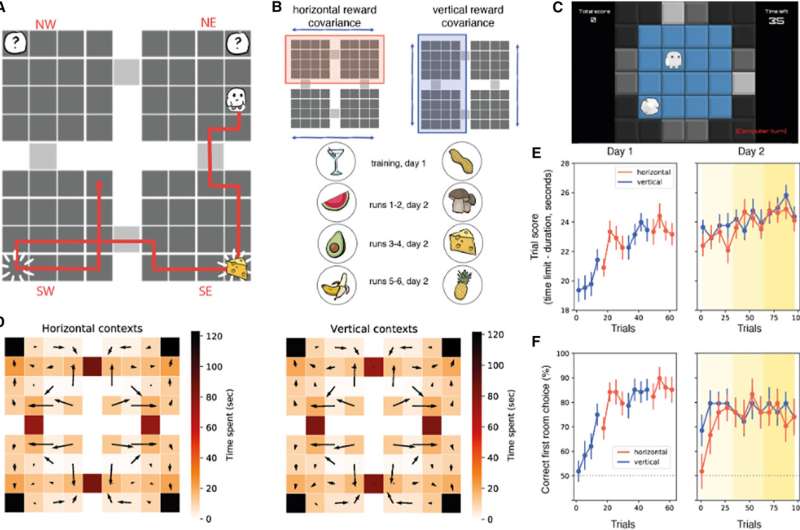January 4, 2024 feature
This article has been reviewed according to Science X's editorial process and policies. Editors have highlighted the following attributes while ensuring the content's credibility:
fact-checked
peer-reviewed publication
trusted source
proofread
Cognitive maps in some brain regions are compressed during goal-seeking decision-making

Human decision-making has been the focus of a wide range of research studies. Collectively, these research efforts could help to understand better how people make different types of everyday choices while also shedding light on the neural processes underpinning these choices.
Findings suggest that while making instantaneous decisions, or in other words, choices that need to be made quickly based on the information available at a given moment, humans greatly rely on contextual information. This contextual information can also guide so-called sequential decisions, which entails making a choice after observing the sequential unfolding of a process.
Researchers at the University of Oxford, the National Research Council in Rome, University College London (UCL), and the Max Planck Institute for Human Development recently carried out a study exploring the impact of context on goal-directed decision-making. Their findings, published in Neuron, suggest that goal-seeking 'compresses' spatial maps in the hippocampus and orbitofrontal cortices in the brain.
"Humans can navigate flexibly to meet their goals," Paul S. Muhie-Karbe, Hannah Sheahan, and their colleagues wrote in their paper. "We asked how the neural representation of allocentric space is distorted by goal-directed behavior. Participants navigated an agent to two successive goal locations in a grid world environment comprising four interlinked rooms, with a contextual cue indicating the conditional dependence of one goal location on another."
To further explore what happens in the brain during goal-directed decision-making, the researchers carried out an experiment involving 27 human participants. These participants completed a task on a computer screen, which entailed navigating a virtual environment by controlling an avatar.
This avatar could move through a partially visible world represented in a grid form. This virtual world included four different rooms connected to each other, and the participants only saw the room that their avatar was occupying from above (i.e., with a bird's eye view).
During each experimental trial, the participants' avatar appeared in a room picked at random, and the participants were asked to move it using buttons on a keyboard to pick up rewards by colliding with some boulders while avoiding boulders that were empty.
At the beginning of each trial, the participants were also offered a contextual cue, which concealed partial clues hinting (but not clearly disclosing) where the rewards could be found within the virtual world. Notably, as the participants completed this task requiring goal-directed decision-making, their brain activity was recorded by an fMRI scanner.
"Examining the neural geometry by which room and context were encoded in fMRI signals, we found that map-like representations of the environment emerged in both hippocampus and neocortex," Muhie-Karbe, Sheahan, and their colleagues wrote.
"Cognitive maps in hippocampus and orbitofrontal cortices were compressed so that locations cued as goals were coded together in neural state space, and these distortions predicted successful learning. This effect was captured by a computational model in which current and prospective locations are jointly encoded in a place code, providing a theory of how goals warp the neural representation of space in macroscopic neural signals."
Essentially, Muhie-Karbe, Sheahan, and their colleagues found that the environment that was virtually accessed by participants was encoded in the form of a map in some parts of their brains, particularly the hippocampus and neocortex. Interestingly, however, these cognitive maps were somewhat compressed, coding locations that were relevant to the goal they were trying to achieve together.
These results shed new light on the neural underpinnings of goal-directed decision-making, suggesting that the brain could utilize compression mechanisms to contextually modulate sensory information during decision-making to achieve a specific goal. In the future, new studies could further investigate these compression processes, which could lead to fascinating new discoveries.
More information: Paul S. Muhle-Karbe et al, Goal-seeking compresses neural codes for space in the human hippocampus and orbitofrontal cortex, Neuron (2023). DOI: 10.1016/j.neuron.2023.08.021. www.sciencedirect.com/science/ … ii/S0896627323006323
© 2024 Science X Network



















